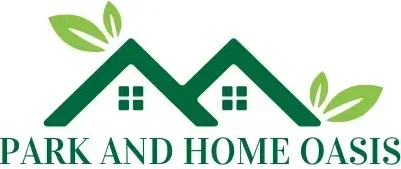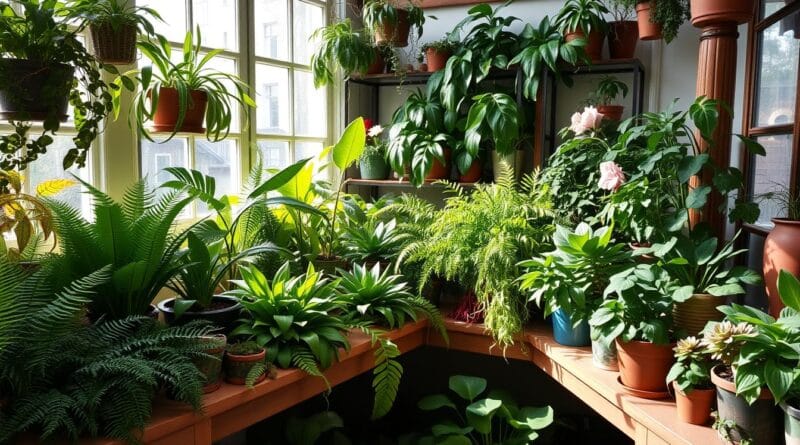Indoor Gardening: A Complete Guide for Beginners 2025
Imagine turning your home into a lush oasis. This is the magic of indoor gardening. It makes your space beautiful and purifies the air. This guide will teach you how to grow a thriving garden, even in small spaces.
Indoor gardening is perfect for anyone who loves plants. It’s great for city dwellers and experienced gardeners alike. We’ll cover everything from picking the right plants to setting up your space. Your journey into indoor gardening will be fun and rewarding.
Table of Contents
Key Takeaways
- Discover the benefits of indoor gardening, including air purification and the joy of cultivating plants in limited spaces.
- Learn how to choose the perfect plants for your indoor environment, considering factors like light, temperature, and space requirements.
- Understand the essential tools and equipment needed to set up a thriving indoor garden, from growing containers to specialized lighting systems.
- Explore techniques for effective water management and humidity control, ensuring your plants thrive indoors.
- Gain insights into the importance of soil selection and potting mix essentials for optimal plant growth.
Getting Started with Indoor Gardening: Essential Tools and Equipment
Starting your indoor gardening journey needs the right tools and equipment. You’ll need to pick the best growing containers and understand potting mixes and grow lights. This section will help you set up a thriving indoor garden.
Basic Tools Every Indoor Gardener Needs
You’ll need a few key tools for a smooth indoor gardening experience. These include top-notch container gardening pots or planters, a reliable watering can, and a trowel for transplanting. Also, get sharp pruning shears, a soil thermometer, and a pH meter to check your potting mixes.
Setting Up Your Indoor Garden Space
Location is key for a great indoor garden. Pick a spot with plenty of light, whether from natural light or grow lights. Think about temperature, humidity, and air circulation to make a perfect microclimate for your plants.
Understanding Growing Containers
The right container gardening vessel is crucial for your plants’ health and growth. Choose containers with good drainage to avoid waterlogging. Pick the right size based on your plants’ mature size. Terracotta, plastic, and self-watering pots are all good options, each with its own benefits.
“The key to successful indoor gardening lies in the right tools and setup. With the proper equipment and a thoughtful approach, you can create a thriving indoor oasis that brings nature inside your home.”
Choosing the Right Plants for Your Indoor Garden
Choosing the right plants is key to a thriving indoor garden. Homeowners need to think about light, space, and air-purifying plants. There are many options, from easy-to-grow microgreens to vertical gardens that save space.
Microgreens are a great choice for indoor gardens. They are packed with nutrients and taste great. They grow well in small spaces, making them perfect for tight spots. Plus, they help clean the air, improving your indoor air quality.
Vertical gardens are great for saving space. They let you grow many plants on a wall. This not only saves floor space but also makes your room look better, turning walls into green walls.
| Plant Type | Light Requirements | Air Purification | Space Efficiency |
|---|---|---|---|
| Microgreens | Moderate to high | Excellent | Compact |
| Vertical Gardens | Varies by plant | Depends on plant selection | Highly efficient |
| Snake Plant | Low to moderate | Excellent | Compact |
| Peace Lily | Moderate | Excellent | Moderate |
When picking plants, think about their light needs, air-purifying abilities, and space requirements. By choosing wisely, you can make a beautiful, air-purifying indoor space that improves your home’s feel.
Understanding Light Requirements and Grow Light Systems
Lighting is key for indoor gardens. It’s important for growing veggies, herbs, or flowers. Knowing the difference between natural and artificial light helps gardeners set up the best conditions for their plants. This includes those in hydroponic systems.
Natural vs. Artificial Light Solutions
Natural sunlight is the best for plants. It has all the light they need to grow well. But, not all places get enough sunlight, especially in winter or with little window space. Artificial grow lights can help, letting gardeners control the light their plants get.
Types of Grow Lights
- Fluorescent grow lights: These bulbs are energy-saving and come in different colors. They’re great for small gardens.
- LED grow lights: LED lights last long, save energy, and focus on specific wavelengths plants need.
- High-Intensity Discharge (HID) grow lights: HID lights, like metal halide and high-pressure sodium, give strong light. They’re used in bigger gardens or hydroponic systems.
Light Duration and Intensity
How much and how bright light plants need varies. Most plants need 12-18 hours of light a day. The brightness depends on the plant’s needs. Growers can use a light meter to check if their plants have the right amount of light.
By knowing what plants need and choosing the right grow lights, gardeners can make a lush indoor space. This is true even without natural sunlight.
Soil Selection and Potting Mix Essentials
Choosing the right potting mixes is key for indoor container gardening and seed starting. The soil you pick can greatly affect your plants’ growth and health.
Indoor gardening needs special soil. Regular garden soil is too heavy for containers. It can cause drainage and aeration problems. So, go for a potting mix made for indoor use.
These mixes have peat moss, perlite, vermiculite, and compost. They give the right mix of nutrients, air, and water for your plants. The right potting mix helps your plants grow well in containers.
If you want to make your own potting mixes, know what your plants need. Succulents and cacti need a dry mix, while African violets like moist soil. Trying different mixes can help meet your plants’ needs.
“The secret to successful indoor gardening lies in the soil beneath your feet.”
The success of your indoor garden starts with the right potting mix. Quality soils set your plants up for success and a good harvest.
Water Management and Humidity Control
Proper water management is key for a successful indoor garden. The right watering techniques keep plants healthy and prevent pests. Managing humidity is also vital for plant growth.
Proper Watering Techniques
Watering indoor plants needs a careful touch. Too little water causes wilting, while too much leads to root rot. Water based on your plant’s needs, like soil type and size.
Check the soil moisture before watering. Add water only when the top inch is dry.
Humidity Requirements for Different Plants
Plants have different humidity needs. Tropical plants like orchids need 60-80% humidity. Succulents and cacti prefer drier air, around 40-50%.
Adjusting humidity levels is crucial for your plants’ health.
Common Watering Mistakes to Avoid
Don’t overwater or underwater your plants. Other mistakes include not adjusting watering for seasons and using the wrong water temperature. Also, ensure proper drainage.
By avoiding these mistakes, your plants will get the right amount of water to thrive.
FAQ
What are the essential tools and equipment needed for indoor gardening?
Every indoor gardener needs basic tools. These include pots, a good potting mix, a watering can, pruning shears, and grow lights if needed. Also, having a dedicated indoor garden space with the right lighting and air is key.
How do I choose the right plants for my indoor garden?
Pick plants based on light needs, size, and air-purifying abilities. Succulents, herbs, leafy greens, and easy plants like pothos and snake plants are good choices.
What are the different types of grow lights and how do I determine the right light setup?
Grow lights come in LED, fluorescent, and HID types. The right light depends on the plant’s needs. Make sure to match the light’s intensity and duration for healthy growth.
How do I properly water and manage humidity for my indoor plants?
Watering is key. Check soil moisture before watering and avoid too much water. Plants have different humidity needs. Use misting or pebble trays to keep humidity right.
How do I create the perfect potting mix for my indoor plants?
A good potting mix drains well and is rich in nutrients. Mix peat moss, compost, vermiculite, and perlite. Adjust the mix based on your plants’ needs.
How can I prevent and manage pests in my indoor garden?
Good air flow and regular checks can prevent pests. If pests show up, use organic solutions like insecticidal soaps or neem oil. This keeps your plants safe.
What are the benefits of growing microgreens and vertical gardens indoors?
Microgreens are packed with nutrients and easy to grow indoors. Vertical gardens use wall space well. Both add nature and clean air to your home.

